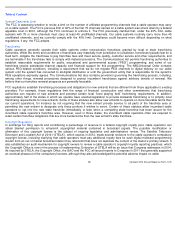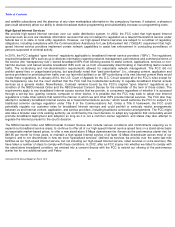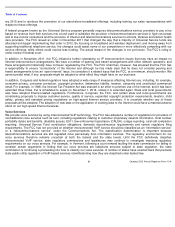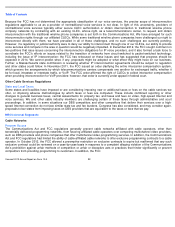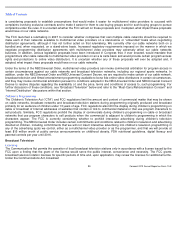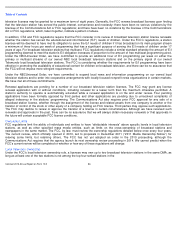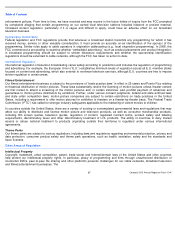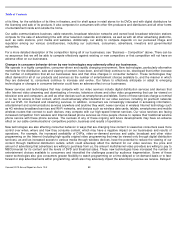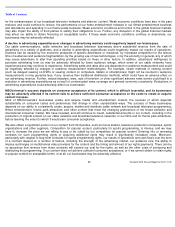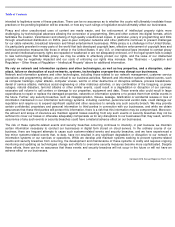Comcast 2013 Annual Report Download - page 34
Download and view the complete annual report
Please find page 34 of the 2013 Comcast annual report below. You can navigate through the pages in the report by either clicking on the pages listed below, or by using the keyword search tool below to find specific information within the annual report.
Table of Contents
personal information and new data security and data retention requirements, and also expand the scope of COPPA to reach third-
party service providers that knowingly collect personal information through a child-directed website or service.
We are also subject to state and federal regulations and laws regarding information security. Most of these regulations and laws
apply to customer information that could be used to commit identity theft. Substantially all of the U.S. states and the District of
Columbia have enacted security breach notification laws. These laws generally require that a business give notice to its customers
whose financial account information has been disclosed because of a security breach. In addition, we maintain an identity theft
program that incorporates the guidance provided under the FTC’s “red flag rules,”
which are designed to detect the warning signs of
identity theft. The FTC and state attorneys general also have initiated efforts to increase and enforce transparency requirements
about the collection and use of consumer information, even in de-
identified form. These requirements may require ongoing review
of new and rapidly evolving technologies and methods for delivering content and advertising to ensure that appropriate notice is
given to consumers and consent is obtained where required.
In February 2013, the President directed the National Institute of Standards and Technology, in cooperation with other federal
agencies and owners and operators of U.S. critical infrastructure to develop a voluntary framework that provides a prioritized,
flexible, repeatable, performance-based, and cost-
effective approach to cyber risk, which was released in February 2014. It is a
compendium of existing, cross-
sector cyber defense processes, practices, and protocols that can help companies identify, assess,
and manage their cyber risks and vulnerabilities. Additionally, there are pending legislative proposals that could impose new
requirements on owners and operators of critical infrastructure. We cannot predict what proposals may ultimately be adopted or
how such requirements, if any, would affect our businesses.
We are also subject to state and federal “do not call”
laws regarding telemarketing and state and federal laws regarding unsolicited
commercial emails, as well as FCC regulations relating to automated telemarketing calls, texts or SMS messages. Additional and
more restrictive requirements may be imposed if and to the extent that state or local authorities establish their own privacy or
security standards or if Congress enacts new privacy or security legislation.
Advertising Restrictions
Legislation has been introduced and reports from various government agencies have been issued from time to time urging that
restrictions be placed on advertisements for particular products or services, including prescription drugs and the marketing of food
or violent entertainment to children, and on the deductibility of advertising expenses. We are unable to predict whether such reports
would result in legislative proposals, whether legislative proposals may be adopted, or, if adopted, what impact they would have on
our businesses.
Environmental Matters
Certain of our business operations are subject to environmental laws and regulations and involve air emissions, wastewater
discharges, and the use, disposal and cleanup of toxic and hazardous substances. Any failure to comply with environmental
requirements could result in monetary fines, civil or criminal sanctions, third-
party claims or other costs or liabilities. We have been
responsible for the cleanup of environmental contamination at some of NBCUniversal’s current and former facilities and at off-
site
waste disposal locations, although our share of the cost of such cleanups to date has not been material. In addition, the California
Attorney General and the Alameda County, California District Attorney are investigating whether certain of our waste disposal
policies, procedures and practices are in violation of the California Business and Professions Code and the California Health and
Safety Code. See Item 3, Legal Proceedings, in this Part I for more information.
29
Comcast 2013 Annual Report on Form 10
-
K


